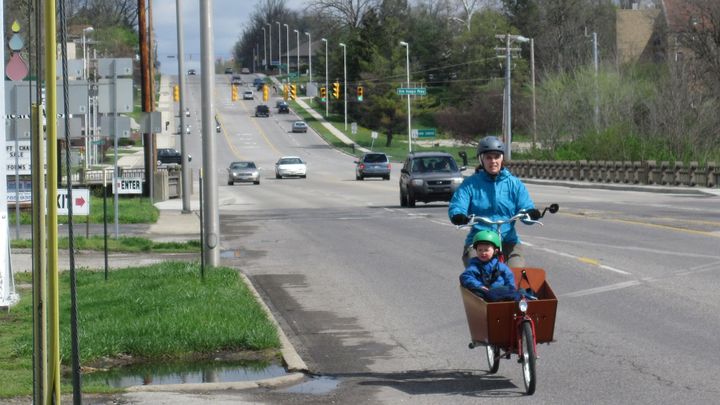Effective bike advocacy in the face of declining city budgets

One approach to bike advocacy is to believe that persuading the the right people in government is the way to get things done.
Here in Richmond, Indiana, the issue is generally not getting the local government on board to support cycling, it’s that the city budget seems to be in an ongoing decline. There aren’t particularly funds for non-critical projects, and there may be less funds next year. It’s a tough time to launch any new government initiative that involves local tax dollars.
My approach to bike advocacy is to believe that a small group of committed citizens can create positive change. With strategy and creativity there’s plenty that can be done while the city budget is in decline. Here’s a summary of what we’ve done here in Richmond, what’s planned, and what’s possible.
Removing “NO BIKES” signs
Getting “NO BIKES” signs removed downtown was the catalyst for forming ‘Bike Richmond’. A petition was circulated to have the signs removed. The petition was presented to the mayor, who readily accepted it and ordered the signs removed. This cost nothing to organize, and no new budget items for the city. The project was relatively fast to execute, and made our downtown more welcoming to bikes and visitors.
Creating and printing bike maps
I already documented the process of producing bike maps in detail. Creating bike maps improved the real and perceived viability of bicycling in Richmond. The bike route network was approved by the city, but the maps were funded privately by a small handful of donors. As an agile, independent project, we were able to produce 5,000 maps for about $2,000. Omaha, a much larger city, recently spent over $50,000 to produce the same number of maps, while Cincinnati still struggles to update a decade-old map. For creating bike maps, the smaller physical size of our town worked to our advantage and so did having fewer layers of local bureaucracy.
To proceed, I have several ideas for bike advocacy efforts that that can be effective without significant local government spending:
Educate ourselves
Ground zero is educating ourselves. There’s plenty to learn for free on the internet and through library books. Physically or virtually visiting functional bike communities is also inspirational.
Educate others
Taking a hard look a national and local bike injury data, it’s clear that many accidents are due to uneducated or irresponsible cycling, such as riding at night without lights and not following the rules of the road. There’s plenty of potential for bike-related education, and the simplest formats can be free: you just need an instructor and some students to show up.
Improve access to bikes
Bloomington, Indiana has a Community Bike Project, which is a volunteer-driven effort that accepts donated bikes, fixes them up, and gives them away or sells them extremely cheaply. The project is a win for the donors, a win for the volunteers who improve their bike maintenance skills, and a win for the recipients who get a great deal on a smooth running bike.
Pursue a bike/pedestrian coordinator for the city
If you city doesn't yet have a "Bicycle and Pedestrian Coordinator" position, it doesn't hurt to start asking. Possibilities for getting started with a bike/ped coordinator for the city could include using an intern or a volunteer. I gave a sample job description for this position to the Mayor to clarify what this position could do, which could include keeping bike issues on the radar for new road construction, organize events like bike-to-work day, and generally be a resource for bike information, inside and outside of city government.
In the long term, this position should be funded by the city to demonstrate its commitment to this part of its Comprehensive Plan to be a “sustainable city”.
Develop ‘Art Racks’
As creative individuals, we can come up with more interesting and visually appealing than bike racks than a standardized city program might roll out. This might be a high school welding class project to produce custom ‘art racks’ to be installed downtown. It’s likely the city would approve them on public property (other cities have), but they could also be placed at local businesses with only private permission.
Learn from the best
I have been fortunate that some bike advocacy experts have sought me out to offer help. Nancy Tibbets from the Indiana Bicycle Coalition drove across the state to meet with local bike advocates. And Greg Raisman, a Traffic Safety Specialist, noticed I was visiting Portland and offered to spend a long lunch break with me. Both provided great advice. With people like this out there passionate to help, imagine what could happen with a little effort to seek out mentors and directly ask for help.
Plan for bike lanes
One of Greg’s tips was to buy a $10 measuring wheel on eBay, which could be used to accurately measure a road width by simply walking across it. That has enabled us to start DIY bike lane planning. Rather than waiting for the city to develop a bike lane plan, experienced cyclists can measure key roads ourselves and develop a solid plan for striping some existing roads, referencing the standard widths for car and bike lanes. We will of course needs the cities cooperation, but we can get the ball rolling by developing a specific proposal.
Greg also offered great tips for how we might re-purpose existing roads. One concept is called the Road Diet. Another is Bike Boulevards. Both avoid costly construction of new facilities. Instead they make current facilities better for bicycling, and generally safer for drivers and pedestrians as well. We can consider these approaches as part of our proposed bike lane plan.
Pursue state funds
Nancy provided another great tip: While our local funds are dried up, there are Indiana state funds for bike safety education that are hardly being applied for. With some organizational effort, our community could apply for and receive and a $75,000 grant for bike safety education. Funds like that could pay to offer a bike safety education course to every six grader in the city.
Influence current projects
Advocates in Frankfort, Kentuckly recently successfully intervened in an update of Route 421 there. By switching from a “standard rural” road layout to a “standard urban” layout, they were able to add bike lanes to a stretch of road without requiring a wider right-of-way, or significant project cost changes.
In Richmond, we could be working more closely with the city to review the planned updates for 27, 40 and South E Street, to insure that they have the interests of cyclists in mind. The City’s current Comprehensive Plan calls for supporting a “non-motorized network” around the city, so we are helping the City to support its own stated goals.
Have fun!

Finally, I don’t underestimate the value of simply getting out, riding a bike, and having fun. People notice, and fun is contagious. Copenhagen Cycle Chic has the right idea. When we follow through on several of this points, we will have demonstrated commitment and results that the City will consider when local funds are available. These cost-effective efforts will also put our City in a better position to be awarded state and federal funds for more extensive bicycle facility updates.



Comments ()